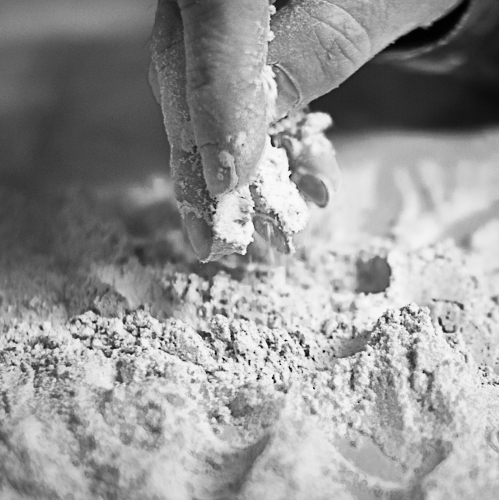Holli mill is located in a place called Spydeberg where organically cultivated grains are ground into flour with millstones. Besides, the cereals are required to be near to the original types of grain which have not been hybridised by man.
We paid a visit to miller Terje Nesje at his mill in Spydeberg on Saturday 18 April. After having arrived, we were invited to his office where he gave us a short lecture on cereals starting with einkorn and emmer, which were domesticated in the Fertile Crescent, corresponding to present-day Iraq, Syria, Lebanon and southern Turkey, about 9,000 years ago. Both einkorn and emmer are types of wheat and the latter has somehow given rise to spelt wheat through hybridisation with wild goat-grass. Source: wikipedia
He also told us about the Finns who arrived in Norway in the 1600’s and who practised slash-and-burn agriculture. After having burnt an area of the forest, they put rye grains in their mouths in order to water them before putting them in the ground. When the grains were full-grown, they let their cows eat the grain. In this way, the cows aided in spreading the rye and fertilizing it at the same time.
Contrary to modern wheat, spelt wheat has long roots which are able to find nutrients and water deep down, while modern wheat has short roots and is dependent on artificial irrigation and getting nutrients from fertilizers located close to its roots. In addition, spelt has a long stem making it more difficult for parasites to climb from the ground up to the ear. In spite of these positive traits, none of the aforementioned types of cereal are widely cultivated for the simple reason that they have a lower harvest than modern types of cereals. Thus, they are unfortunately grown only because more or less affluent and health-conscious people are willing to pay higher prices for flour or bread made from these types of cereals.
Besides telling us about cereals, he also gave us a vivid description of the smell of the flours which arises when grinding the different types of cereals.
Being concerned about teaching children about the way from cereals to bread, he sometimes visits kindergartens bringing a handheld mill. In this way, the children are shown how grains are ground into flour.
It is a goal for the miller that the cereals he are receiving should be cultivated organically and preferably grown locally. Thus, in addition to cultivating his own cereals, he’s receiving cereals from up to 40 different farms. Before grinding, samples of the cereals are tested for humidity because there is a requirement to the highest amount of humidity. Thus, the cereals first have to be dried, before they are cleaned and then ground. When grinding, the distance between the millstones is adjusted until the smell and sound are as wanted. Of course, the grains are ground slowly and carefully in order to avoid excess heat. We have experienced something similar during roasting of coffee beans at the coffee bar of Tim Wendelboe.
Terje Nesje learnt how to grind grain into flour from an old, now deceased, miller from a place called Sarpsborg. Since almost all flour in Norway is produced industrially, the trade of miller hardly exists any more. Thus, in order to gain experience and meet other millers, he is in touch with Swedish and Danish farmers.
Holli mill is producing flour from the following types of cereals:
- wheat
- rye
- emmer
- barley
- spelt
Fortunately, the mill has a good distribution and sales to selected bakeries. Besides, it is also possible to buy flour directly from the mill and from the Sunkost food-chain in Norway.
In the end, we were told about his pearl grain in which he has great confidence. Pearl grain is made from spelt, barley and rye and it can be cooked as rice and risotto.

